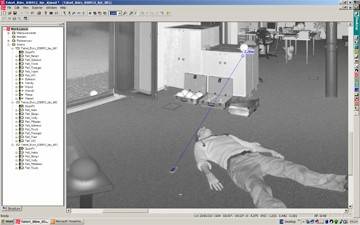Laser scanning is rapidly gaining acceptance and becoming more and more commonplace in the law enforcement and accident reconstruction communities. Over the past few years, hardware and software have improved significantly creating a simpler, overall system to capture immense detail in a short period of time.
These are 10, of the many, reasons to consider laser scanners for a forensic application:
1) Easy to use: Many manufacturers are moving toward a simpler interface making operation of the scanner more like a digital camera than a complicated survey instrument.
2) Portability: Laser scanners are smaller in size today than ever before making them easier to deploy to a crime/accident scene and useable by just about anyone.
3) Safety: Data can be collected from a distance, with some scanners collected measurements over 300 meters away. This allows the operator to scan a scene out of harms way. In addition, laser scanners can collect up to 1,000,000 points per second with average scan times of several minutes. Less time on a scene means less time for potential danger to the individuals at the scene. Class I lasers are also being used in laser scanners creating a truly eye-safe environment during the scan.
4) Speed and Efficiency: Complete color scans can be captured in as little as several minutes creating a virtual scene with high accuracy and detail that can be revisited over and over without physically traveling to the site. In contrast to traditional methods of surveying/documenting a scene, laser scanning can be much faster and allow multiple investigators to have eyes on the virtual scene.
5) Produce a variety of deliverables: Once the scene has been laser scanned, various types of final products can be extracted or produced from the data. For example, anything from a traditional 2D drawing to a detailed 3D animation can be created from the scan data.
6) ピアの圧力: シーンドキュメントにレーザースキャナを使用する機関が増え、その結果はより広く受け入れられています。将来のシーンが3Dで文書化されることを期待する成長だけでなく。
7) 費用対効果: レーザースキャナーは、従来交通事故の文書化に使用されていた総局と同等の価格になっています。
8) 特殊測定ツール: 3Dデータから法医学分析を行うソフトウェアには、血液スパッタや弾丸軌道、目撃者/容疑者の身長などを測定するための特別なツールも含まれています。
9) 共有が容易: ソフトウェアをインストールしたり、ライセンスを追加購入したりすることなく、スキャンデータを表示および文書化できるソフトウェアツールが増えます。
10) シーンをアーカイブする: シーンがレーザースキャンされると、そのシーンは基本的に時間内に凍結され、シーンを調査したい人が将来のバーチャル訪問に備えて保存されます。これにより、キャプチャ時にも必ずしも重要ではないと思われる測定が可能になります。
